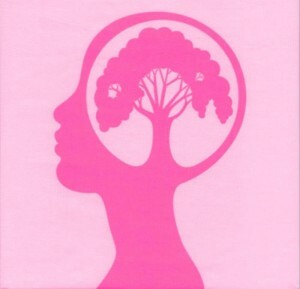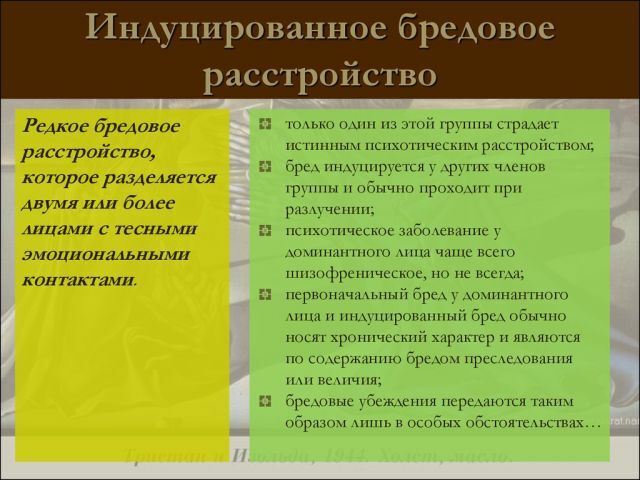 Mentism is a disorder of thinking, which is often one of the symptoms of a mental illness - schizophrenia, and it manifests itself in the form of an influx of various images, scraps of memories and thoughts. Also, this symptomatology is characteristic of neglected phases of neuroses and chronic stress.
Mentism is a disorder of thinking, which is often one of the symptoms of a mental illness - schizophrenia, and it manifests itself in the form of an influx of various images, scraps of memories and thoughts. Also, this symptomatology is characteristic of neglected phases of neuroses and chronic stress.
Thoughts and images can come in brief episodes and last for a while. Thus patients can feel their accumulation and inexpediency, but can not overcome for a long time.
Many of them are forced to be in constant tension of expectation, they are harassed by reflections, which negatively affects the well-being. The presence of obsessive thoughts is continuous, and they can be very diverse. The patient is unable to control their current, stopping the endless flow and switching to new objects.
Often, joyful feelings, characteristic of an optimistic mood, are replaced by accusatory ideas or a state close to depressive.
Characteristic not only of schizophrenia
According to experts, mentism refers to the variant of associative automatism, which is part of the Kandinsky-Clerambo syndrome, which can manifest not only in patients with schizophrenia.
Mentism occurs as an accompaniment of psychotic disorders in alcoholism, exo-organic diseases and others. Can accompany and depressive syndrome, affective disorders, epileptic and traumatic psychoses.
General picture of what is happening
 The patient experiences difficulties with associative thinking, can not arbitrarily move to a new thought, understand the meaning of the questions asked and make judgments.
The patient experiences difficulties with associative thinking, can not arbitrarily move to a new thought, understand the meaning of the questions asked and make judgments.
Even if he understands the question, the answer is delayed.
In the vortex of thoughts, the general meaning of what is happening is lost.
Thus, signs of mentalism are
- state of tension, accompanied by a continuous flow of thoughts that the patient can not control, they are somehow invested in his head forcibly;
- thoughts are often pretentious or paradoxical, distracting from daily affairs and communicating with loved ones, there is a viscosity of thinking;
- the duration of such a state is unpredictable, it can be from several seconds to several days;
- object of reflection can be any thing that has fallen on the eye of the patient, as a result develops paralogical thinking, which loses the necessary stability and logic, jumps of thoughts succeed each other, constantly changing direction;
- the beginning and end of this state can be sudden.

Features of thinking with mentalism
It is not difficult for a specialist to divide mentism with slowing and inhibition of thinking, which are characteristic of organic brain lesions, such as encephalitis or swelling. It should be remembered that mentism is very often a symptom of schizophrenia, determined by genetic predisposition.
Depending on the disease that caused the manifestations of mentalism, it can be realized in different forms:
- So when depression there is a flow of anxious and negative thoughts, feelings of fear, guilt or shame. Some future problems come up. A fixation on illnesses, suicide or even the image of one's own burial, and for the patient they seem attractive, although he is afraid of their embodiment.

- With asthenic syndrome , hypersensitivity to irritating factors appears: light, sounds, smells.
- The consequences of physiological trauma are accompanied by inhibition of thought processes. Hypnagogic mentism, characterized by an influx of thoughts before falling asleep, can manifest itself. Pathology can manifest itself in the form of fantasies, when patients claim that they had contact with aliens, under which they were susceptible to research and fence organs.
- When schizophrenic states thoughts turn into a kaleidoscope of rapidly changing images, the content of which is very different.
Symptoms and Diagnosis
Since this disorder of thinking is a symptom of various diseases of the neurological and psychiatric nature, first of all it is necessary to determine the initial disease, each of which has its own characteristic features.
For mentism of any nature, the following are common features:
- the patient's confidence that thoughts arising in his head appear not at his will;
- often patients feel that others can easily read their thoughts;
- sometimes there is a symptom of echoes, in which the patient believes that his thoughts are spoken by others;
- the ability to talk mentally with people who, according to the patient's ideas, are being persecuted.
It's impossible to diagnose yourself, only a specialist can do it. In this study refers to the manifestation of the disease, which also needs to be established. Accordingly, and treatment is prescribed for the underlying disease.
Diagnostic system consists of several stages: 
- pathopsychological examination;
- selection of a comprehensive methodology with the possibility of using studies that help to more accurately establish a diagnosis;
- establishing a "working diagnosis", adopted as a basis;
- establishing a definitive diagnosis during a certain period of observation;
- monitoring by the doctor of the patient's condition during treatment and correction of the technique depending on the patient's condition.
Complex of activities
The patient needs professional psychiatric care, which helps to remove the syndrome and increase the periods of remission. Often a patient can not independently consult a specialist, his consciousness does not allow him to really assess his own condition.
In such a case, the decision to visit the clinic should be made by close people who observe negative changes. Thus, as it was spoken above, to put the definitive diagnosis, only the expert with appropriate formation can.
Therapy is performed within the framework of the underlying disease, taking into account the manifested symptoms of mentalism. Kandinsky-Clerambo disease is treated in a hospital. The doctor decides on the necessary therapeutic procedures and their orientation. The main goal is to suppress pseudo-hallucinatory and delusional symptoms.
In schizophrenia, medication is prescribed in the course of treatment, which includes neuroleptics, which if necessary can be combined with antidepressants.
In addition to drugs, the use of psychotherapeutic techniques is recommended:
- bioresonance therapy;
- gestalt therapy;
- positive psychotherapy;
- hypnotherapy;
- body-oriented psychotherapy;
- existential psychotherapy and others.
 As a rule, the doctor uses an integrated approach, combining several methods, in which case the effectiveness of treatment is much higher.
As a rule, the doctor uses an integrated approach, combining several methods, in which case the effectiveness of treatment is much higher.
Also, to ensure good results, it is necessary to constantly attend consultations with a doctor and perform the appointments assigned to them.
If you have unpleasant symptoms, feelings of discomfort and other complaints, you need to contact a specialist who supervises the patient and tell him about the feelings that have arisen.
Acute form of the syndrome is quickly treated, and its symptoms recede. In chronic form, the clinical picture is more lubricated, and the treatment is more complicated.
With prolonged absence of medical care, personality changes may occur.



